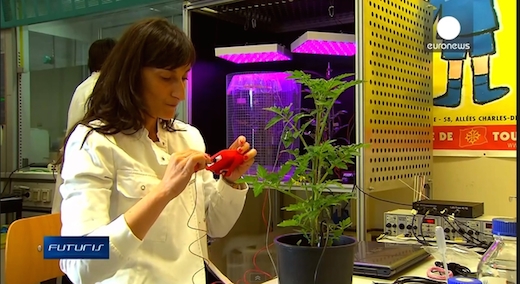
Photo: Video screen capture EuroNews
Plants, just like humans and animals, have a way of communicating with each other. Their language is comprised of electrical signals, through which they send messages to other plants. And now an international group of scientists is developing a way to analyze these electrical signals, and translate them into information we can understand. The project is called PLEASED (PLants Employed As SEnsing Devices) and has already received €1.07 million ($1.46 million) in EU funding.
According to one of the biologists working on the project, Stefano Mancuso, plants can sense the gravitational field, as well as electrical fields, chemicals gradients, and more. The project he is working on aims to translate this vast amount of useful and readily available information. To do this, the team is trying to develop a network of microsensors which can be embedded in plants and trees, and which will them proceed to transmit information about the plants’ response to things like changes in temperature, humidity, air pollution, chemicals and many other changes in their environment.
As Mancuso pointed out, the plants communicate using a real vocabulary, “where each electrical message corresponds to a specific environmental parameter. If we can break the code, we will have a Rosetta Stone for plants, which will tell us what plants are sensing.”
Needless to say, this project could lead to quite a breakthrough in our knowledge about the environment. The kind of digital network and algorithm for decoding the messages that the team is working on would be able to transform every tree into an environmental informer. Just one tree would be able to provide information about several environmental parameters simultaneously. This would include real-time monitoring of the ozone, measuring chemicals used in agriculture, and so one.
In other words the ability to decode the language of plants would provide us with an accurate and all-encompassing snapshot of the state and health of our environment beyond anything we’ve ever had before. The sensors to get this sort of environmental data that are currently in use rely on a single sensor for each parameter, which makes getting such data quite expensive.
Related Articles on JetsonGreen.com:
Discarded Cigarette Butts can be Recycled into Energy Storage Devices
A Glow In The Dark Plant to Replace Lights?
Net Zero ADAPT Home Reduces the Need for Climate Control in the Chihuahua Desert
[source: http://feedproxy.google.com/~r/jetson_green/~3/zgybeNzIupU/listening-to-plants.html]

Leave a Reply
You must be logged in to post a comment.